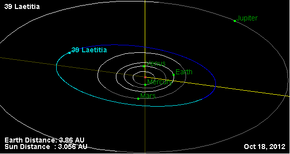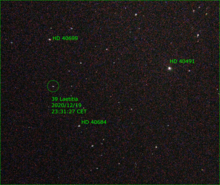 | |
| Discovery | |
|---|---|
| Discovered by | J. Chacornac |
| Discovery date | 8 February 1856 |
| Designations | |
| MPC designation | (39) Laetitia |
| Pronunciation | /lɛˈtɪʃiə/ |
| Named after | Laetitia |
| Minor planet category | Main belt |
| Orbital characteristics | |
| Epoch 31 December 2006 (JD 2454100.5) | |
| Aphelion | 461.503 Gm (3.085 AU) |
| Perihelion | 366.877 Gm (2.452 AU) |
| Semi-major axis | 414.190 Gm (2.769 AU) |
| Eccentricity | 0.114 |
| Orbital period (sidereal) | 1,682.713 d (4.61 a) |
| Mean anomaly | 58.261° |
| Inclination | 10.383° |
| Longitude of ascending node | 157.168° |
| Argument of perihelion | 209.560° |
| Physical characteristics | |
| Dimensions |
|
| Mass | (4.72±1.14)×10 kg |
| Mean density | 2.47±0.63 g/cm |
| Synodic rotation period | 0.2141 d (5.138 h) |
| Geometric albedo | 0.287 (geometric) |
| Spectral type | S |
| Apparent magnitude | 8.97 to 12.18 |
| Absolute magnitude (H) | 6.1 |
| Angular diameter | 0.142″–0.051″ |

39 Laetitia is a large main-belt asteroid that was discovered by French astronomer Jean Chacornac on 9 February 1856 and named after Laetitia, a minor Roman goddess of gaiety. The spectrum matches an S-type, indicating a stony (silicate) composition. It is orbiting the Sun with a period of 4.61 years and is spinning on its axis once every 5.1 hours.
Photometric observations of this asteroid gathered between 1968 and 1974 were used to build a light curve that provided shape and rotation information. It has the general shape of an elongated triaxial ellipsoid with ratios between the lengths of the axes equal to 15:9:5. Major surface features are on a scale of 10 km and the surface color does not vary significantly across the surface. In the ecliptic coordinate system, the pole of rotation is estimated to be oriented to the coordinates (λ0, β0) = (121°±10°, +37°±10°).
In 1988 a search for satellites or dust orbiting this asteroid was performed using the UH88 telescope at the Mauna Kea Observatories, but the effort came up empty. Photometric observations collected during 2006–08 were used to measure time variations of the asteroid light curve. This data suggests that the asteroid may have a complex shape or it could be a binary asteroid system. Observations of an occultation on 21 March 1998, produced several chords indicating an ellipsoidal cross-section of 219 km × 142 km.
References
- John Craig (1869) The Universal English Dictionary
- ^ Yeomans, Donald K. "39 Laetitia". JPL Small-Body Database Browser. NASA Jet Propulsion Laboratory. Retrieved 7 April 2013.
- ^ "1998 European Asteroidal Occultation Results". euraster.net (a website for Asteroidal Occultation Observers in Europe). 21 March 1998. Retrieved 1 December 2008. (Chords) Archived 23 July 2011 at the Wayback Machine
- ^ Carry, B. (December 2012), "Density of asteroids", Planetary and Space Science, vol. 73, pp. 98–118, arXiv:1203.4336, Bibcode:2012P&SS...73...98C, doi:10.1016/j.pss.2012.03.009. See Table 1.
- "Asteroid Lightcurve Parameters". Planetary Science Institute. Archived from the original on 14 June 2006. Retrieved 3 November 2008.
- "Asteroid Data Archive". Planetary Science Institute. Archived from the original on 23 May 2006. Retrieved 3 November 2008.
- "AstDys (39) Laetitia Ephemerides". Department of Mathematics, University of Pisa, Italy. Archived from the original on 27 March 2012. Retrieved 26 June 2010.
- "Numbered Minor Planets 1–5000", Discovery Circumstances, IAU Minor Planet center, retrieved 7 April 2013.
- Sather, R. E. (January 1976), "Minor planets and related objects. XIX – Shape and pole orientation of 39 Laetitia", Astronomical Journal, vol. 81, pp. 67–73, Bibcode:1976AJ.....81...67S, doi:10.1086/111854.
- Gradie, J.; Flynn, L. (March 1988), "A Search for Satellites and Dust Belts Around Asteroids: Negative Results", Abstracts of the Lunar and Planetary Science Conference, vol. 19, pp. 405–406, Bibcode:1988LPI....19..405G.
- Vereshchagina, I. A.; et al. (August 2009), "Some specific features of light curves of (39) Laetitia, (87) Sylvia, (90) Antiopa, and 2006 VV2 asteroids", Solar System Research, vol. 43, no. 4, pp. 291–300, Bibcode:2009SoSyR..43..291V, doi:10.1134/S0038094609040030.
External links
- 39 Laetitia at AstDyS-2, Asteroids—Dynamic Site
- 39 Laetitia at the JPL Small-Body Database

| Minor planets navigator | |
|---|---|
| Small Solar System bodies | |||||||
|---|---|---|---|---|---|---|---|
| Minor planets |
| ||||||
| Comets | |||||||
| Other | |||||||